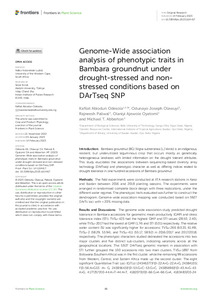| dc.contributor.author | Odesola, K.A. |
| dc.contributor.author | Olawuyi, O.J. |
| dc.contributor.author | Paliwal, R. |
| dc.contributor.author | Oyatomi, O. |
| dc.contributor.author | Abberton, M. |
| dc.date.accessioned | 2023-11-27T10:30:47Z |
| dc.date.available | 2023-11-27T10:30:47Z |
| dc.date.issued | 2023 |
| dc.identifier.citation | Odesola, K.A., Olawuyi, O.J., Paliwal, R., Oyatomi, O. & Abberton, M. (2023). Genome-wide association analysis of phenotypic traits in Bambara groundnut under drought-stressed and non-stressed conditions based on DArTseq SNP. Frontiers in Plant Science, 14: 1104417, 1-14. |
| dc.identifier.issn | 1664-462X |
| dc.identifier.uri | https://hdl.handle.net/20.500.12478/8339 |
| dc.description.abstract | Introduction: Bambara groundnut (BG) (Vigna subterranea [L.] Verdc) is an indigenous, resilient, but underutilized leguminous crop that occurs mostly as genetically heterogeneous landraces with limited information on the drought tolerant attributes. This study elucidates the associations between sequencing-based diversity array technology (DArTseq) and phenotypic character as well as differing indices related to drought tolerance in one hundred accessions of Bambara groundnut. Methods: The field experiments were conducted at IITA research stations in Kano and Ibadan between 2016 and 2018 planting seasons. The experiments were arranged in randomised complete block design with three replications, under the different water regimes. The phenotypic traits evaluated was further to construct the dendrogram. Genome-wide association mapping was conducted based on 5927 DArTs loci with < 20% missing data. Results and Discussions: The genome wide association study predicted drought tolerance in Bambara accessions for geometric mean productivity (GMP) and stress tolerance index (STI). TVSu-423 had the highest GMP and STI values (28.50, 2.40), while TVSu-2017 had the lowest at GMP (1.74) and STI (0.01) respectively. The relative water content (%) was significantly higher for accessions; TVSu-266 (60.35, 61.49), TVSu-2 (58.29, 53.94), and TVSu-411 (55.17, 58.92) in 2016/2017 and 2017/2018, respectively. The phenotypic characters studied delineated the accessions into two major clusters and five distinct sub-clusters, indicating variations across all the geographical locations. The 5,927 DArTseq genomic markers in association with STI further grouped the 100 accessions into two main clusters. TVSu-1897 from Botswana (Southern Africa) was in the first cluster, while the remaining 99 accessions from Western, Central, and Eastern Africa made up the second cluster. The eight significant Quantitative Trait Loci (QTLs) (24346377|F|0-22:A>G-22:A>G, 24384105|F|0-56:A>G33 :A> G, 24385643|F|0-53:G>C-53:G>C, 24385696|F|0-43:A>G-43:A>G, 4177257|F|0-44:A>T-44:A>T, 4182070|F|0-66:G>A-66:G>A, 4183483|F|0-24:G>A-24:G>A, 4183904|F|0-11:C>T-11:C>T) identified with Bonferroni threshold was in association with STI, indicative of variations under the drought-stressed condition. The observation of consistent SNPs in the 2016 and 2017 planting seasons, as well as in combination with the 2016 and 2017 planting seasons, led to the designation of these QTLs as significant. The drought selected accessions could form basis for hybridization breeding. The identified quantitative trait loci could be useful in marker-assisted selection in drought molecular breeding programs. |
| dc.description.sponsorship | International Institute of Tropical Agriculture |
| dc.format.extent | 1-14 |
| dc.language.iso | en |
| dc.subject | Groundnuts |
| dc.subject | Grain Legumes |
| dc.subject | Chromosomes |
| dc.subject | Drought |
| dc.subject | Single Nucleotide Polymorphism |
| dc.subject | Food Security |
| dc.subject | Bambara Groundnut |
| dc.title | Genome-wide association analysis of phenotypic traits in Bambara groundnut under drought-stressed and non-stressed conditions based on DArTseq SNP |
| dc.type | Journal Article |
| cg.contributor.crp | Grain Legumes |
| cg.contributor.crp | Roots, Tubers and Bananas |
| cg.contributor.affiliation | Bells University of Technology, Nigeria |
| cg.contributor.affiliation | International Institute of Tropical Agriculture |
| cg.contributor.affiliation | University of Ibadan |
| cg.coverage.region | Africa |
| cg.coverage.region | West Africa |
| cg.coverage.country | Nigeria |
| cg.coverage.hub | Headquarters and Western Africa Hub |
| cg.researchtheme | Biotech and Plant Breeding |
| cg.identifier.bibtexciteid | ODESOLA:2023 |
| cg.isijournal | ISI Journal |
| cg.authorship.types | CGIAR and developing country institute |
| cg.iitasubject | Agronomy |
| cg.iitasubject | Food Security |
| cg.iitasubject | Grain Legumes |
| cg.iitasubject | Plant Breeding |
| cg.iitasubject | Plant Production |
| cg.journal | Frontiers in Plant Science |
| cg.notes | Open Access Journal |
| cg.accessibilitystatus | Open Access |
| cg.reviewstatus | Peer Review |
| cg.usagerightslicense | Creative Commons Attribution 4.0 (CC BY 0.0) |
| cg.targetaudience | Scientists |
| cg.identifier.doi | https://doi.org/10.3389/fpls.2023.1104417 |
| cg.iitaauthor.identifier | Olaniyi Oyatomi: 0000-0003-3094-374X |
| cg.iitaauthor.identifier | Michael Abberton: 0000-0003-2555-9591 |
| cg.futureupdate.required | No |
| cg.identifier.issue | 1104417 |
| cg.identifier.volume | 14 |

